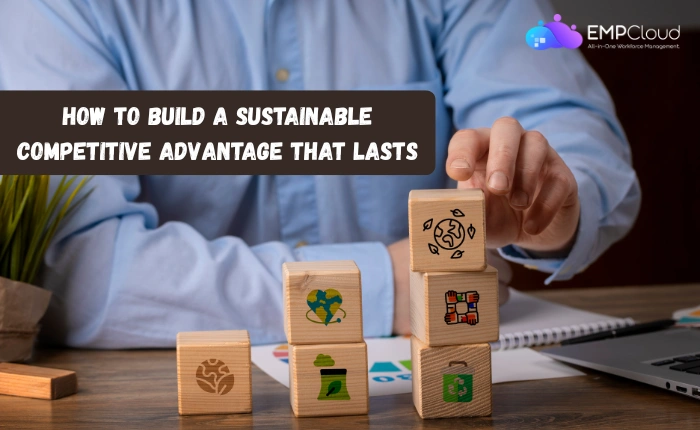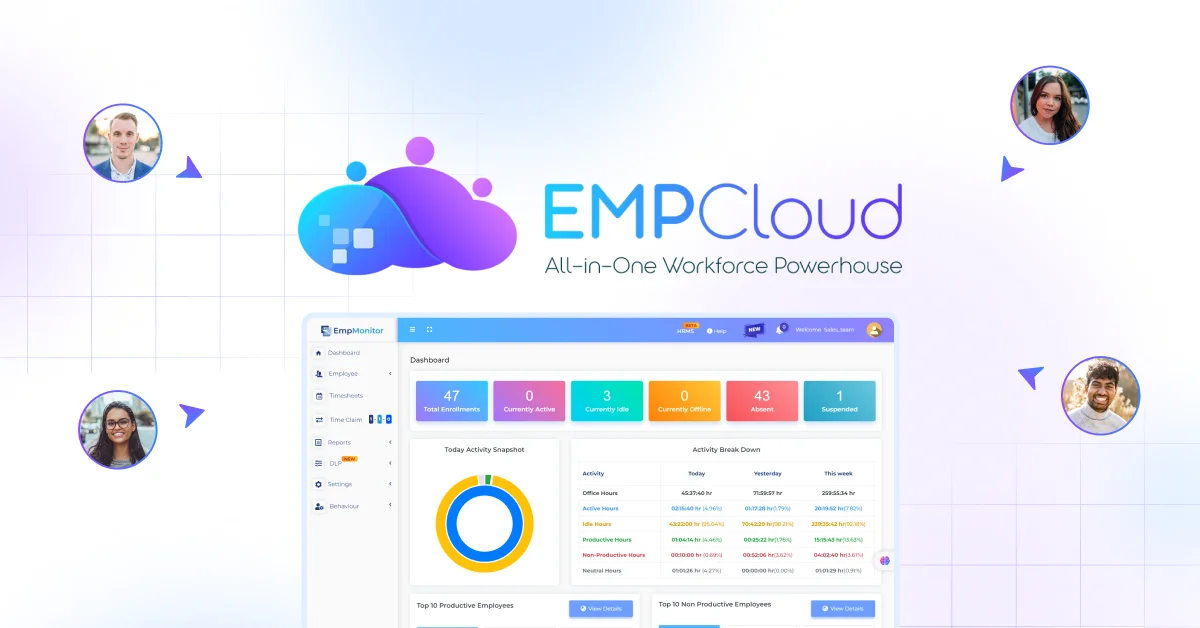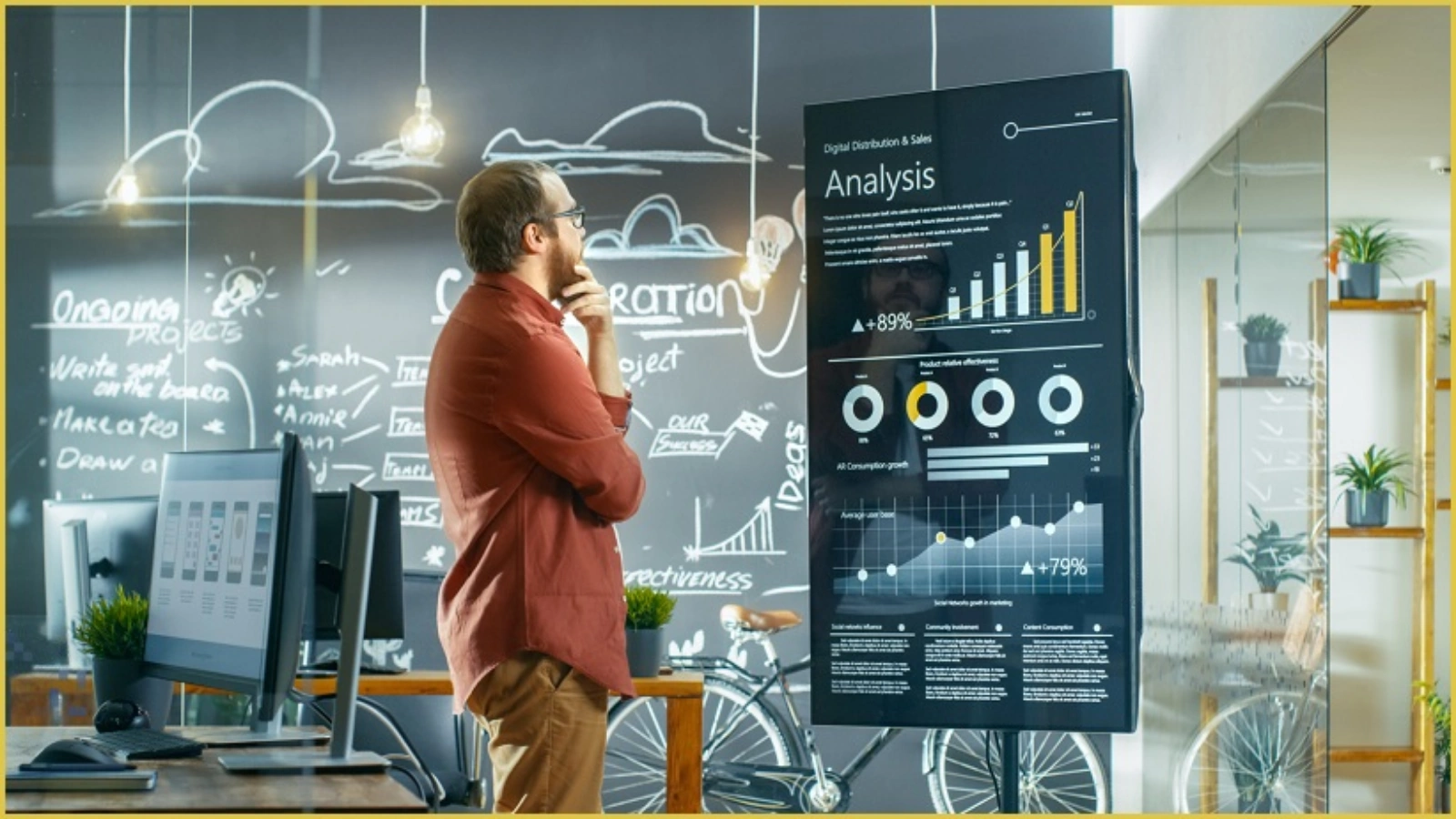
Businesses are constantly battling to stand out, win customers, and grow despite tough competition. What allows some companies to stay on top for decades while others fade away? The real difference lies in building a sustainable competitive advantage, a long-term strength that keeps a business ahead even when markets evolve or new competitors enter.
Companies that secure a sustainable competitive advantage don’t rely on luck; they use smart strategies and powerful resources that customers won’t find elsewhere.
This blog explores how businesses can build and protect a sustainable competitive advantage and why it matters today more than ever.
In a hurry? Listen to the blog instead!
What Does Long-Term Competitive Edge Mean In Business?
Before applying the concept, leaders must understand what is a sustainable competitive advantage. It represents a company’s ability to deliver ongoing superior value that competitors cannot easily copy or replace. It ensures that the company continues to outperform the market in a durable and profitable way — from innovation to how they flextime manage workforce productivity.
To better understand, here’s a sustainable competitive advantage example:
Apple maintains strong brand loyalty, patented technologies, and a seamless ecosystem that competitors find very difficult to imitate. This keeps customers returning year after year, despite premium pricing.
A sustainability of competitive advantage supports:
Consistent Growth:
It helps companies remain stable and profitable even in uncertain environments or competitive pressure. When competitors struggle to keep up, these businesses continue expanding. Their future becomes more predictable because their strengths are long-term and well-protected.
Premium Pricing Power:
Customers are willing to pay more due to strong trust, product differentiation, or innovative features. Even when cheaper alternatives exist, the perceived value justifies a higher price. This leads to increased revenue and healthier profit margins over time.
Long-Term Customer Loyalty:
People repeatedly choose the brand because of reliability, emotional connection, or exceptional experiences. Retaining a customer costs far less than acquiring a new one, so loyalty improves financial efficiency. It also turns buyers into advocates who recommend the brand to others.
Stronger Brand Reputation:
A respected brand attracts more opportunities, partnerships, and higher-quality talent. Customers feel confident in brands known for consistency, innovation, and responsibility. As reputation grows, marketing becomes easier and competition becomes less threatening.
Short-term tactics, like extreme discounts or viral social trends, may boost visibility temporarily. But companies with a sustainable competitive advantage stay relevant for decades because competitors cannot easily duplicate their core strengths. That’s what makes them truly irreplaceable in the customer’s mind.
Also Read:
How To Use Flextime Manager To Boost Team Productivity?
Why Is Competitive Advantage More Critical Now?
Technology has democratized innovation, giving every business the power to compete globally. Consumers now have more options than ever, and markets evolve at a rapid pace. To thrive in this environment, brands must understand SCA meaning to business.
The strategic strengths that help organizations stay ahead consistently. Without a sustainable competitive advantage, even top players can quickly lose their relevance.
A strong positioning delivers:
Protection from competitors — Your unique value keeps rivals from replacing you easily.
Long-term profitability — Strong demand and brand trust fuel consistent revenue growth.
Room to expand — Businesses can confidently explore new markets and product lines.
Customer retention — Trust, familiarity, and reliability keep customers returning.
Organizations with a sustainable competitive advantage stay more resilient and competitive, outperforming brands that rely only on short-lived success tactics.
How Does Sustainability Influence Business Success?
Modern consumers expect brands to be ethical, transparent, and environmentally responsible. This shift has turned sustainability as a competitive advantage into a powerful business strategy that influences customer preference and brand trust.
When implemented seriously, sustainable practices do more than protect natural resources; they reinforce a sustainable competitive advantage by cutting waste, improving operational efficiency, and strengthening long-term loyalty. Even workplace culture benefits — instead of negative behaviors like malicious compliance, employees feel motivated to contribute meaningfully when they see their organization acting with purpose.
Customers feel more confident choosing companies that show responsibility and contribute to a better future, helping these businesses grow stronger and remain relevant over time.
What Are The Key Factors Behind Lasting Business Growth?
Today’s customers expect brands to behave responsibly, operate transparently, and minimize environmental harm. This expectation has turned sustainability into a competitive advantage into a major driver of long-term success.
Customer Trust & Loyalty:
When companies act ethically and reduce their environmental footprint, customers feel more confident choosing them. This emotional alignment creates deeper loyalty and encourages repeat purchases. Over time, trust becomes a strong shield against competitors.
Operational Efficiency & Cost Savings:
By reducing waste, energy usage, and unnecessary resources, sustainability cuts avoidable expenses. These improvements make operations more efficient and resilient during market challenges. The saved costs can fuel innovation or expansion.
Stronger Brand Reputation & Market Value:
A responsible brand image attracts positive attention from media, investors, and communities. This boosts credibility and brand preference in competitive markets. A respected reputation becomes part of the company’s sustainable competitive advantage, keeping it relevant for the future.
Better Talent Attraction & Retention:
Employees want to work for brands they believe in and feel proud of. Sustainable companies attract skilled professionals who contribute to higher productivity. A motivated and passionate workforce becomes a powerful growth asset.
Future-Ready Legal & Market Compliance:
Sustainability helps businesses stay ahead of evolving laws, regulations, and consumer expectations. Companies avoid penalties and disruptions while gaining early mover benefits. This creates long-term stability that competitors struggle to copy.
Also Read:
Malicious Compliance: Understanding The Hidden Workplace Challenge
What Are The Major Sources Of A Long-Term Competitive Lead?
Different companies draw strength from various sources of sustainable competitive advantage, elements that help them outperform rivals over the long run.
These advantages are not only valuable but also hard for competitors to replicate, making them powerful strategic assets. Some of the major sources include:
Patented Technologies: Unique inventions protected by law allow companies to sell exclusive products and prevent competitors from copying their innovations.
Strong Brand Loyalty: A trusted brand keeps customers coming back, even when competitors offer similar products, reducing marketing costs and increasing customer lifetime value.
Cost Leadership: Companies that master efficient production can offer lower prices than rivals and still maintain profitability. This acts as a strong barrier to entry for others.
Exclusive Supply Chains: Securing rare materials, superior logistics, or long-term supplier relationships ensures consistent quality and gives a company leverage in the market.
High Technical Expertise: A skilled workforce and advanced know-how enable faster innovation, better problem-solving, and continuous improvement.
Strategic Partnerships & Alliances: Collaborations with key players (manufacturers, distributors, technology experts, etc.) expand capabilities and market reach without heavy internal investment.
The harder these sources are to imitate, the stronger and more sustainable the advantage becomes.
How Does Innovation Drive Market Leadership?
Innovation keeps companies ahead of shifting markets and evolving customer needs. Businesses that continuously improve their products, services, and processes establish a sustainable competitive advantage by staying relevant when others fall behind.
Innovation is not just about technology; it also includes new ways of delivering value, optimizing experiences, advancing professional development, and simplifying decisions across the organization.
When companies adopt tools like Empcloud to track performance, streamline task management, and monitor field operations, they reinforce their innovative culture and strengthen their competitive edge.
How Important Is Human Talent In Business Success?
People are the true drivers of success. A skilled, motivated workforce gives an organization a sustainable competitive advantage that no competitor can duplicate.
When teams are empowered, engaged, and aligned with business goals, productivity soars and innovation thrives.
And here’s where modern workforce technology makes a massive difference.
How Does EmpCloud Empower Workforce Advantage?
Organizations aiming to elevate productivity, employee engagement, and decision-making are increasingly adopting advanced workforce platforms, and EmpCloud plays a pivotal role in this transformation. It streamlines everything from onboarding and task allocation to performance insights and attendance, helping businesses respond faster and work smarter.
By simplifying people operations and enabling data-driven leadership, EmpCloud turns the workforce into a true source of strength. This not only boosts operational efficiency but also reinforces a sustainable competitive advantage built on talent, agility, and continuous improvement.
Manager-Centric Solutions
EmpCloud provides leaders with the tools to manage performance, monitor teams, and drive growth effectively:
- Time & productivity tracking
- Field geo-location monitoring
- Task and project management
- Client information and interaction history
- Data protection and secure reporting
- Real-time analytics for smarter decisions
With these insights, managers lead with precision instead of guesswork, ensuring teams stay aligned and accountable.
HR-Centric Workforce Innovation
EmpCloud redefines HR management with automation and clarity:
- Face-recognition attendance and secure access
- Automated leave & attendance tracking
- Policy and document management
- Smart timesheets and shift scheduling
- Hassle-free payroll automation
- Streamlined exit and compliance handling
By simplifying every HR process, organizations save time and minimize errors, giving HR teams room to focus on strategy instead of paperwork.
Centralized Data Intelligence
EmpCloud unifies workforce data under one dashboard, offering a panoramic view of employee performance and engagement:
- Live location and task tracking
- Attendance and timesheet reports
- Project allocation and productivity metrics
- Actionable insights for better decisions
This integrated visibility transforms workforce data into business intelligence, the foundation of smarter growth decisions.
EmpCloud turns workforce excellence into a measurable competitive edge, leading to better service, higher productivity, and unbeatable market performance.
How Does Technology Strengthen Competitive Position?
Digital transformation enables companies to work faster, smarter, and with greater precision. Technology supports a sustainable competitive advantage by improving scalability, increasing data accuracy, and elevating the overall customer experience, things that are difficult for competitors to replicate quickly.
Businesses leveraging automation, AI, and real-time analytics can instantly respond to changing market demands, optimize operations, and provide faster resolutions, all essential for long-term leadership and revenue growth.
Moreover, advanced workforce technologies like EmpCloud enable companies to unlock hidden productivity, streamline collaboration, and ensure seamless tracking of performance and attendance. When organizations integrate such tools, they enhance innovation, minimize inefficiencies, and build a powerful advantage that strengthens over time.
How Do Brands Measure Their Advantage?
A true sustainable competitive advantage can be measured through key business metrics such as:
- Revenue and profit consistency
- Repeat purchase rates
- Market share growth
- Brand recognition and customer satisfaction
These indicators show whether a company’s strengths truly translate into lasting success.
Also Read:
How To Achieve Professional Growth And Advance Your Career?
What Prevents Competitors From Imitating Success?
Competitors often fail to copy success because the winning formula involves culture, relationships, and proprietary systems, not just surface-level strategies. This combination creates a sustainable competitive advantage that’s deeply embedded in the organization’s DNA, making it difficult or too costly to duplicate.
Many companies also develop long-term trust with customers, partners, and employees — something that can’t be replicated overnight. When this trust is reinforced by unique capabilities and continuous improvement, it becomes almost impossible for rivals to match the value offered, even if they try to imitate the visible parts of the business.
What Happens If Companies Stop Innovating?
Innovation is the driving force behind long-term success. When businesses stop improving their products, services, and processes, they lose momentum and struggle to stay relevant in a rapidly evolving market.
- Loss of Competitive Edge – Competitors with fresher ideas and advanced technologies quickly move ahead.
- Declining Customer Satisfaction – Customers expect better experiences; outdated offerings push them to alternatives.
- Stagnant or Negative Growth – Lack of innovation limits expansion opportunities and slows revenue and market share.
- Brand Becomes Outdated – The company loses visibility and relevance as consumer trends shift.
- Rising Operational Inefficiencies – Old systems and methods become costly and hamper productivity over time.
- Difficulty Attracting and Retaining Talent – Ambitious employees prefer workplaces that encourage creativity and progress.
- Higher Risk of Disruption – New entrants with breakthrough ideas can completely replace slow-moving market leaders.
What Should Businesses Do To Start Building Their Advantage Today?
Every business, big or small, can start building a long-term edge by focusing on unique value, strengthening customer trust, and empowering employees.
Here’s how:
- Identify and protect your unique strengths
- Adopt technology like EmpCloud to optimize workforce efficiency
- Invest in innovation and data-driven decisions
- Prioritize customer satisfaction and loyalty
- Build a strong organizational culture
Companies that take these steps early create a sustainable competitive advantage that becomes nearly impossible to break.
Final Thoughts
The business world changes daily, but organizations with strong, evolving foundations rise above competitors. A sustainable competitive advantage isn’t just a strategy; it’s a long-term survival plan.
Leaders must ask themselves:
What do we do better than anyone else?
How can we maintain and enhance it?
What investments make that position future-proof?
Brands that answer these questions with clarity and action will not only survive, they’ll lead their industries for decades.
And when future-ready tools become part of the journey, platforms like EmpCloud help businesses strengthen their workforce, boost performance visibility, and turn talent into a sustainable competitive advantage.
FAQs
Q1: What is the biggest challenge in maintaining a sustainable competitive advantage?
The biggest challenge is staying ahead of changing customer expectations and market trends. Even strong advantages can fade if businesses fail to innovate and adapt consistently.
Q2: How long does it typically take to build a sustainable competitive advantage?
It varies by industry, but building a strong advantage usually takes years of investment in capabilities, brand trust, customer relationships, and innovation, not just short-term campaigns.
Q3: Can small businesses also develop a sustainable competitive advantage?
Yes! Small businesses can leverage agility, niche specialization, personalized service, and community trust to create powerful advantages that larger competitors struggle to replicate.
Q4: How does customer experience contribute to competitive advantage?
A memorable customer experience boosts loyalty, referrals, and brand reputation. When customers feel valued and understood, they are much less likely to switch to competing brands.








